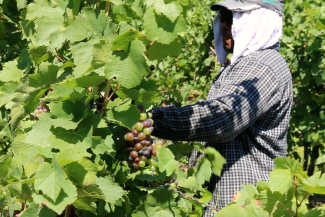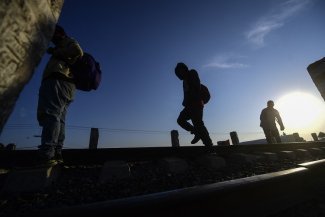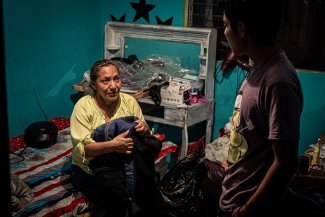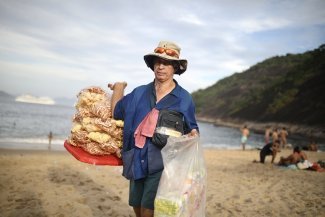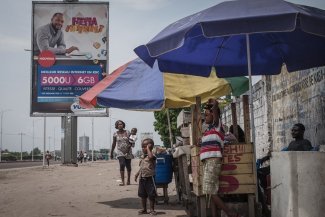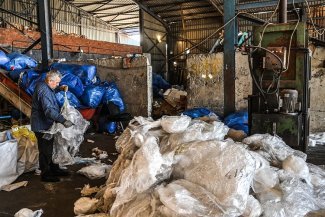In this photo, taken on 17 June 2023, protesters take part in a three-day march in Montreal against the expansion of the Safe Third Country Agreement between the United States and Canada, which activists say undermines refugee rights, fails to deter irregular border crossing, and results in tragic consequences for people on the move.
On a cold June day tainted by a biting drizzle, a group of about 200 adults and children, laden with backpacks and pushing strollers and bikes, climbed up the stairs and crossed Montreal’s Jacques Cartier Bridge. This bridge bears the name of a 15th-century French explorer, whose violent and exploitative interactions with Indigenous Canadians have been well-documented and is also known for being one of the leading forces behind the extinction of great auk birds.
These protesters were escorted by police officers on bikes, evoking images of Middle Eastern asylum seekers who entered Europe in 2015, walking along the sides of motorways, the Latin American migrants undertaking their long journeys to the United States on foot, and the African migrants journeying across the Sahara to reach Europe.
Nevertheless, a marked distinction set this group apart from those departing the Middle East, Latin America and Africa. As they embarked southwards towards the US-Canada border, in place of worn-out footwear and makeshift ponchos assembled from hefty plastic bags, these individuals were outfitted with hiking shoes, waterproof rain jackets, and warm clothes.
On 17 June, this multicultural crowd comprising different ages and nationalities began a three-day hike, covering 73 kilometres, toward an informal US-Canada border crossing called Roxham Road in Quebec. Their objective was to voice opposition to an expansion of the Safe Third Country Agreement (STCA), freshly ratified by the court two days earlier.
For Barbara Haisette, a women’s rights activist based in Montreal, this march symbolised a strong protest against new policies that she said not only heighten the physical and metaphorical barriers for those seeking sanctuary but it would also make it easier for authorities to confine them within detention centres or repatriate them to other countries.
“The march was very symbolic because we only had to walk only several kilometres throughout the entire day. It was a show of solidarity with immigrants and refugees who, for their part, have to walk for hundreds of kilometres, for months or even years, to find a safe place to live,” Haisette told Equal Times.
Undermining refugee rights
Since its implementation in 2004, the STCA has obliged refugees who want to cross the US-Canada border to seek asylum in the first of the two countries that they arrive in. But according to the Migration Policy Institute: “As originally negotiated, the requirement applied only to crossings at ports of entry, and not between, thus creating the loophole that led to Roxham Road becoming an unofficial entry point for a growing number of asylum seekers from around the world – and a flashpoint in Canadian domestic politics.”
By extending the agreement to invalidate the asylum claim of any migrant who makes an irregular crossing between the US and Canada, many rights campaigners and groups dedicated to aiding refugees assert that the STCA undermines human rights principles, stripping immigrants of their core entitlement to find a secure haven. One of those activists is Sandra Cordero, 54, who, along with her kin, fled Chile after the 1973 CIA coup and, after being stranded in Ecuador for five years, eventually settled in Montreal in 1979.
Cordero and other members at Le Droit De Vivre En Paix Montreal, an NGO offering support to refugees and migrants, participated in the march to draw attention to the diminishing rights of asylum seekers in Canada.
“As a Geneva Convention signatory, Canada should disengage from the STCA. This accord is against the fundamental rights of refugees as recognised by the convention and undermines their rights to asylum in Canada,” she told Equal Times, referencing rights such as the right not ‘to be expelled’ and ‘freedom of movement’, which are addressed in the 1951 Convention Relating to the Status of Refugees.
“I perceive that the US and Canada regard one another as safe havens, and denying refugees their rights based on this premise is a distinctly prejudiced manoeuvre rooted in contemporary colonialism and imperialism,” Cordero added.
“These nations shut their doors to refugees even though they are contributing to the conditions that displace people. A clear example of this is the environmental crisis stemming from Canadian mining activities in Chile, driving innumerable Chileans to abandon their residences,” she underscored, hinting to the 53 Canadian mining firms in Chile that have triggered ecological crises, as observed in the Vizachitas and Maricunga projects.
Futile border restrictions
The Safe Third Country Agreement started making rounds in North America back in 2002 when the US and Canada shook hands on the deal as part of the mutual Smart Border Declaration, and on 29 December 2004, the STCA came into action.
The deal – which has many similarities to the landmark Dublin system which provides a framework for asylum applications in the EU and was adopted just one year earlier in 2003 – was as follows: immigrants who applied for asylum in either country could only do so in the first country they landed in. Until 25 March 2023, the eight-kilometre long Roxham Road functioned as an ‘irregular’ border crossing for people in the United States who wished to apply for asylum in Canada. According to the CBC news website, the Canadian government reported that since December 2022 and up until the border crossing closed in March 2023, about 4,500 people were crossing through Roxham Road every month.
While the Canadian government has said that closing the loophole would assist “both governments better manage access to the refugee system in each country for people crossing the Canada–US land border”, Harini Sivalingam, director of the equality programme at the Canadian Civil Liberties Association (CCLA), strongly disagrees:
“Both governments came to this agreement to restrict the ability of the refugees to make claims in respective countries,” she tells Equal Times, criticising the STCA as a “restrictive agreement, law and process, that limits the rights of the refugee to seek protection and asylum in the country that they deem to be safe”.
Sivalingam, who has also assisted immigrants and refugees as a lawyer, suggests that for many asylum seekers, the US is not a safe haven, as many end up behind bars or being sent back to where they fled from.
“Moreover, the US does not have rigorous protection around refugee rights and claims based on gender prosecution, sexual orientation and gender identity. These refugees wouldn’t be able to make a successful claim in the US and would have a better chance to be recognised as refugees in Canada,” she adds.
Crossing the border: “more dangerous than ever”
When the 2002 agreement took effect, its impact was limited to individuals crossing through official land borders. This limitation led to the emergence of alternative pathways like Roxham Road. At the same time, the two countries’ extensive 2,000-kilometre water border transformed into yet another hazardous route for refugees. Some of them never reached their destination, like the Patels, a family of four from India who froze to death in January 2022 while trying to make an irregular crossing into the United States.
“We’ve seen that numerous times, and there are many documented and horrific examples of the risks people have to take because of using the unofficial ports of entry where the agreement didn’t initially apply,” says Sivalingam.
But then, on 24 March 2023, Ottawa and Washington flipped the script, applying the agreement across the entire land and water Canada-United States border. The White House suggested expanding the agreement would “deter irregular immigration” at the two countries’ shared border.
However, as refugee rights groups and activists had forewarned, these measures proved futile in halting irregular border crossings. A tragedy unfolded a week following the agreement’s extension, as evidenced by two separate Indian and Romanian immigrant families, which both included toddlers, who were discovered dead in the half-frozen Saint Lawrence River in Quebec.
“It is now even more dangerous for asylum seekers to cross the border, and this is the problem and danger within this agreement. This will not prevent people from crossing the border. Individuals who need to flee due to facing persecution in their countries of origin will seek refuge, as their lives and safety depend on this. For them, the risk of staying is greater than that of leaving,” Sivalingam emphasises.
Biased immigration policies
Canada has crafted an image of itself as a friendly haven for immigrants and refugees, particularly from the Global South, and its government never misses a chance to assert that “settlement is an integral part of nation building and immigration an intrinsic component of the national heritage”.
Last year, on World Refugee Day, Canadian Prime Minister Justin Trudeau celebrated his country’s efforts in supporting refugees, announcing that “in 2022, for the fourth year in a row, we were the top country in the world to resettle refugees”.
The number Trudeau mentioned was not wrong but it only tells one part of the global migration story. In the larger picture, the North American country is not even among the top ten countries that receive the most refugees or have the highest proportion of refugees in their population in the world.
What Canada practices through its immigration policies is the deliberate handpicking of refugees through resettlement programmes, which often extend beyond its own borders.
This approach has drawn criticism from many activists and refugee rights organisations, and Sivalingam suggests that the immigration policies in Canada are “discriminatory and racialised”, and that people from the Global South, compared to those from visa-exempt countries, face more challenges to enter Canada, regardless of their education level, work experience, and other skills.
Recent reports shedding light on the differing treatment of Afghan and Syrian refugees compared to those escaping the war in Ukraine by Canadian authorities exemplify the inequity at the heart of Canada’s immigration policies.
As one of the participants in the march against the STCA told Equal Times: “My wife is Dutch, so she is being treated here as an expat, but many others from countries not from Europe, who are also highly educated with valuable work experience, are being treated differently by the immigration system,” said a young Canadian man who gave his name as Shawn. “Canada is a country of immigrants. Some came first, some came later. But the country should not be closed to the immigrants who need to come now.”




